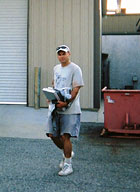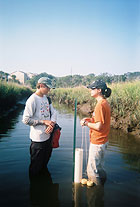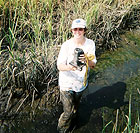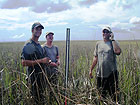

 | |||||||||||||||
|
|
Journals 2006/2007Anna Hilton
July 18, 2006
The next day we divided equipment between boat and vehicles and synchronized our watches planning to meet back at the lab to prepare the water and soil samples we collected. I left with my team and Kolo in the van to head to Postell Creek in Saint Simon. The suburban neighborhood had beautiful large homes and several golf courses. Bike paths beside the streets were filled with bicyclers and pedestrians dressed for summer fun. I wondered if they wondered who we were dressed in long pants as we marched into the marsh with backpacks and a large pole for securing the sonde. We deployed the sonde at the second reach and Kolo found an oyster bank near by. Lisa was concerned that the current of high tide might knock the sonde around so she and Mark made certain the sonde was secure. Mark recorded the time the sonde was set out so that we would know when to pick it up the next day. The sonde collects data every fifteen minutes for twenty-four hours.
After that we began the same procedures we used at Village Creek to collect water and soil samples from each reach at the Postell Creek order. We used the GPS to show us exact locations of the reaches. We had to go to an alternate reach when the water level was too low to sample. All of this was recorded on the data sheet. We took the water samples at each reach first because the reaches were very close together. The water samples were placed in a cooler which Mark was able to carry back to the van because the creek was so close to the road. The soil samples were placed in their labeled bags and put in our backpacks.
It was very interesting to observe the grasses and other plants in the salt marsh. The tidal creek is surrounded with taller and darker cordgrass (Juncus). The pluff mud is much deeper closer to the creek so if you look at the cordgrass you know which spots to avoid when walking to the reaches. Sea oxeye daisy, marsh elder, and pickle grass grew in areas of the marsh that were higher and dryer during the low tide. I learned to look for them when I walked from one reach to another or back to the van. Kolo joined us at the third reach and was disappointed we had not spotted another oyster bed for his sampling as we collected our water samples at each reach. He helped us with the benthic soil samples as we worked our way back through the reaches. My sneaker slipped off in the pluff mud close to the creek at one reach. I was so happy to be able to dig it up. If I had been up to my hips in pluff my shoe would have been lost forever. I retied both muddy shoes very tightly. I think I'll ask Guy for the HML boots that tie around ankles and won't slip off in the deep pluff mud. My investigation of pluff mud continues! As we were walking to the last reach of the day a small raccoon slinked away from us through the marsh. Did you see the QuickTime movie of the raccoon in the virtual field trip to the marsh? So many animals use the salt marsh for food and for protection. They must really be adapted to the harsh environment. We used our cell phone to call Guy to ask a question about the water levels. Kolo spotted another oyster bank near the last reach, so he headed back to the truck to get a bucket for gathering his samples. I stayed high and dry as Lisa and Mark slid down the pluff mud bank. Mark waded across the creek to get the last soil sample. He was suddenly swimming with sampling equipment held over his head to reach the far side of the creek. A marsh hen twittered an unhappy bird song when Mark moved close to a nest hidden in the marsh. As we headed out of the marsh covered in pluff mud from head to toe, I wondered what the islanders passing by thought we were doing. We were definitely not tourists but scientists hard at tidal creek monitoring and assessment.
We met the other teams back at the lab. We were all tired from the morning sampling and hungry for lunch, but everyone had work to do before we went back to Best Western to wash up for lunch. Kolo immediately went to work processing the oysters in the lab. This work had to be done immediately at the lab. He cut open the oysters and made slides for his microarray oyster study back at HML. The equipment, our pants, boots, and shoes had to be rinsed of and laid out to dry. The water and soil samples had to be refrigerated. Samples that are taken out of South Carolina are sent to another lab for analysis so Guy had to make sure they were packaged correctly for the trip. Everyone pitched in to make short work so we were soon on our way back to the Best Western and lunch on our own. Later, at dinner, the leaders of each team talked about the tide and the departure times for each team the next morning. |
||||||||||||||



